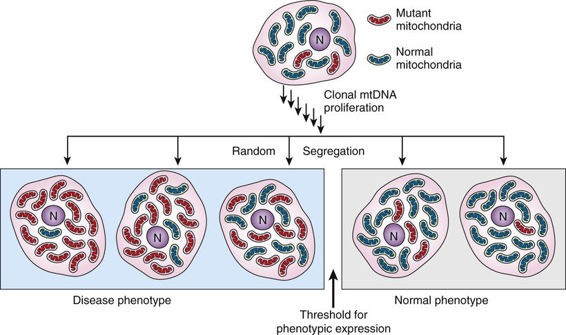Replicative Segregation
A second feature of the mitochondrial genome is the stochastic nature of segregation during mitosis and meiosis. At cell division, the multiple copies of mtDNA in each of the mitochondria in each cell replicate and sort randomly among newly synthesized mitochondria, in stark contrast to the highly predictable and programmed segregation of the 46 nuclear chromosomes. The mitochondria themselves, in turn, are then distributed randomly between the two daughter cells. This process is known as replicative segregation and can result in significant variability in manifestations of mitochondrial disorders among different tissues and/or patients.
Homoplasmy and Heteroplasmy
Finally, a distinctive feature of the genetics of mtDNA is seen when replicative segregation occurs in mitochondria containing both mutant and wild-type mitochondrial genomes. When a mutation first occurs in the mtDNA, it is present in only one of the mtDNA molecules in a mitochondrion. With cell division, all the mtDNAs replicate, the mitochondria undergo fission, and the mutant and wild-type DNA are distributed randomly into daughter organelles, which—simply by chance—may contain different proportions of wild-type and mutant mitochondrial genomes. The cell, which now contains mitochondria containing different mixtures of normal and mutant mtDNAs, in turn distributes those mitochondria randomly to its daughter cells. Daughter cells may thus receive a mixture of mitochondria, some with and some without the mutation (a situation known as heteroplasmy; Fig. 7-25). Occasionally, a daughter cell may receive, again by chance, mitochondria that contain a pure population of normal mtDNA or a pure population of mutant mtDNA (a situation known as homoplasmy). Because the phenotypic expression of a mutation in mtDNA depends on the relative proportions of normal and mutant mtDNA in the cells making up different tissues, reduced penetrance and variable expression are typical features of mitochondrial disorders (Case 33).


Stay updated, free articles. Join our Telegram channel

Full access? Get Clinical Tree


